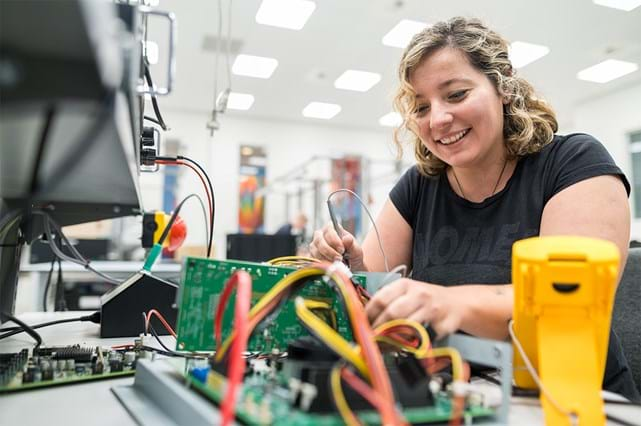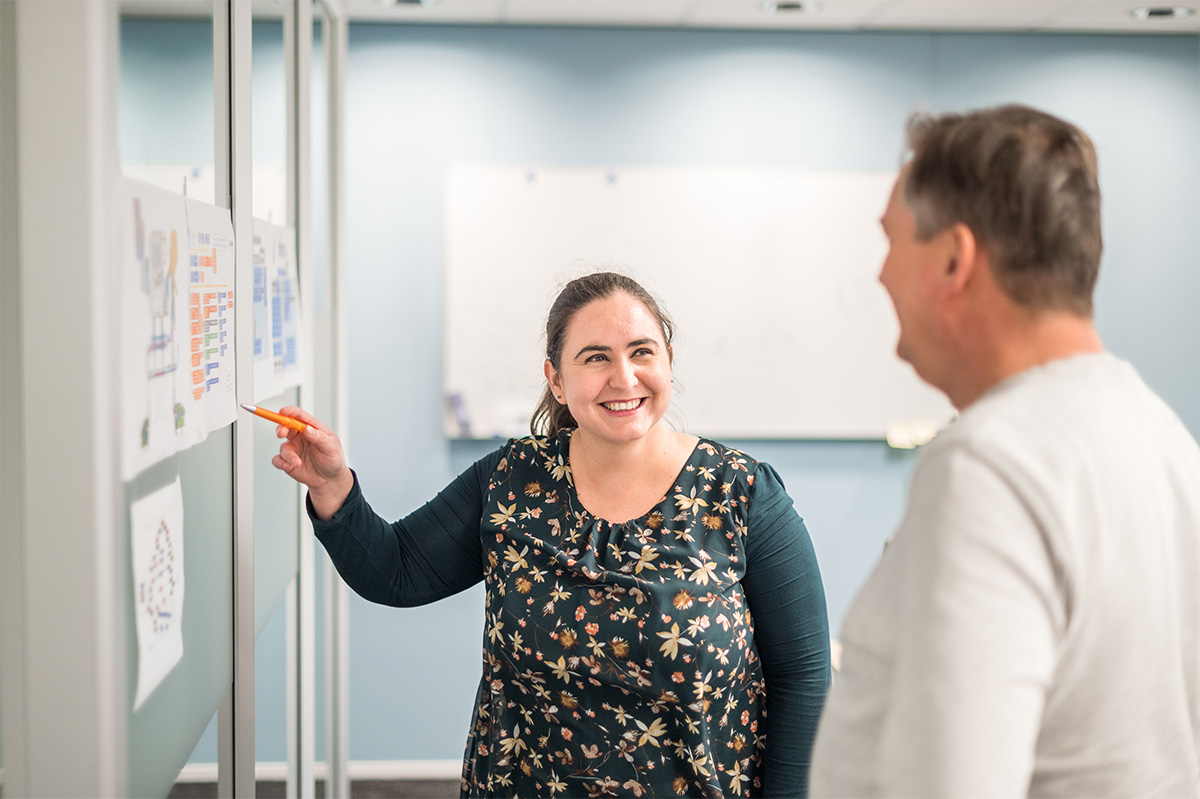Donna-Lee and Tina feel right at home with Sioux
Although they don't mind being the only women in the meeting at all, mechanical designer Donna-Lee van den Bergh (36) and electronics designer Tina Bartulovic (37) always enjoy meeting new, female techies. On one hand, because it's just fun to be with more women, but also because teams composed of both men and women perform better. (Research shows that ladies and gentlemen. Really.) 'If we want more girls to choose a career in engineering, we need to make sure they get to see more female role models. We are happy to help with that.'
Croatian Tina (photo below) remembers exactly when her love for engineering was born: she was 12 and entered a physics competition. 'We had to develop an installation that could turn on a light bulb. The moment when that succeeded was magical for me. I immediately knew I wanted to do this more often,' she says. Now - 25 years later - she is an experienced engineer, but the wonder of those days still sometimes overwhelms her. 'The moment when a design leaves the drawing board and comes to life in the real world... that remains magical. And the beautiful thing is: the more difficult the assignment, the more magical the experience. Sometimes I really think: how is it possible that we can pull this off!'
It was also clear to South African Donna-Lee (photo on the right) early on that she would study engineering. 'My father was an engineer; we always worked on old cars together at home. I also liked playing with LEGO and Mecano, I found it interesting how to make things move. Being one of the few women at university didn't bother me. This was what I wanted.' The same was true for Tina: 'In the first year at university, 30% of all students were women. When I graduated, only two of us were left in our department. But I never felt special. This was just my world.'
Both engineers were brought to the Netherlands by headhunters. The fact that they are women had nothing to do with it. 'I don't believe in quotas and positive discrimination, because then you have to work even harder as a woman to prove you deserve the job. I think the best person should get the job, even if it takes longer to equalize the male/female ratio,' says Tina. For Donna-Lee, the same applies. 'In South Africa, there was a lot of positive discrimination after the abolition of apartheid, to give darker people and women more opportunities. I benefited from this when finding a job, but in the workplace it had the opposite effect: it took longer for me to be taken seriously. What inspired me was my collaboration with the very first woman to graduate in mechanical engineering at my university. She paved the way for me and other women. I strongly believe in outreach programmes through schools. If more girls choose to study engineering, there will naturally be more women engineers.'

Tina has been working at Sioux for three and a half years now and Donna-Lee for three. That, as successful female designers themselves, they are now role models, Tina noticed when she participated in a career event on behalf of Sioux. 'I got talking to a group of female students, they were so excited to meet me. Just the fact that I was standing there apparently meant a lot: I showed them that they too could make a career in electronics. I told them I had chosen Sioux because here you can work on whatever project you want, you learn an awful lot here.'
Both engineers find the working relationships between and men and women in the Netherlands fairly equal. 'Compared to South Africa, the Netherlands is a progressive country,' Donna-Lee believes. 'In my home country, it is mainly the older generation that gives young women a hard time; they clearly have to put more effort into defending a design than a male colleague. In the Netherlands, it is perfectly normal to see fathers walking behind the buggy; many of my colleagues at Sioux also have a Daddy Day. That is not at all common in South Africa.' Yet Tina also sees room for improvement: 'What I do find striking in the Netherlands, despite all those Daddy Days, is that most women start working part-time when they have children. Apparently, they still see themselves as primarily responsible for childcare.'
Both engineers hope that the male/female distribution will become a bit more equal in their industry in the coming years. 'I don't want to generalize, but mixed teams generally function better. Research shows that the working atmosphere is better in organizations with an equal gender distribution; we keep each other on our toes and encourage each other to perform well,' says Donna-Lee. Apart from those facts, sentiment also plays a role, Tina thinks: 'I just think it would be really nice to have more female colleagues. So ladies: come and have a chat at Sioux! And feel free to contact us if you want to know more about our work.'
